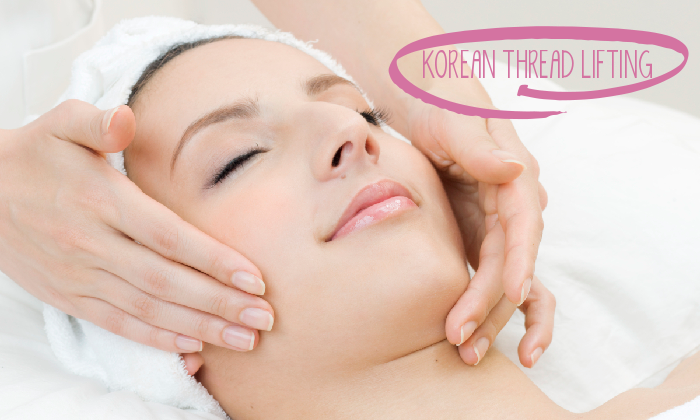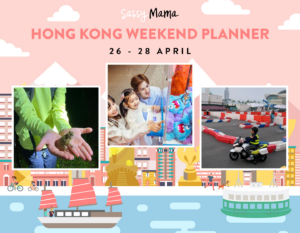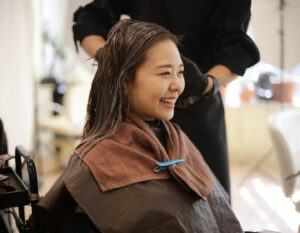
Women interested in getting the lifting and contouring effects that are typically gained through a face lift have been exploring a new, less-invasive and much raved about alternative– Korean Thread Lifting.
WHAT IS IT?
Korean Thread Lifting is a ‘Revolutionary’ treatment and technique developed by Korean plastic surgeons in recent years. Using a series of different types of thread fed through by long needles, the skin is lifted and supported at the subcutaneous level which gives the treated area a firmed and tightened look with a marked improvement in skin tone, as well.
The thread used is made of PDO or PolyDioxanOne, the same material used for surgical sutures, so it will dissolve and be gradually absorbed by the skin. Different types of thread are used for different areas and to achieve the desired results.
WHY DO WOMEN GO FOR IT?
It’s a quicker, less invasive, less expensive way to tighten and lift the skin than a facelift, which requires surgery and extended recovery time.
- It’s quick. Women could potentially pop in for a ‘Lunchtime Facelift’ as the procedure is that quick and simple.
- Though it’s a quick procedure, the results are long lasting.
- Women report having improved skin tone, in addition to the firming and lifting benefits. It improves the look of jowls and skin elasticity.
- Threading also purports to stimulate new collagen growth and generation of elastin. The suture is made with a PLA (PolyLactic Acid) coating, which is the same material that is used in Sculptra and Dermaveil, two collagen boosters. In addition the thread is absorbable.
- It is used to create a slimming effect. In particular, it’s used to achieve the look of a ‘V’ shaped face. It’s also used to ‘slim’ upper arms, and reduce the appearance of double chins.
- The threads also include vitamin C, which also helps with wound healing and recovery
WHAT AREAS CAN BE THREADED?
Areas which are commonly treated with thread lifting are:
- Face– Threading can be used to combat forehead lines, can be used to lift eye brows and cheeks, to smooth under-eye areas and nasolabial folds, to alter the appearance of the nose and slim the jawline.
- Nose –Threading is used to straighten and elevate the nasal bridge, to lift the tip of the nose and subsequently narrow the width of the nose.
- Neck – It can soften lines, slim the muscle to decrease the look of ‘Linebacker Neck’ and slim the arms and improve the appearance of ‘bat wings’.
- Abdomen – Threading has been used to lift skin on the abdomen, but with mixed results.
In TCM (Traditional Chinese Medicine), practitioners insert PDO threads into Meridian points to stimulate metabolism. I tried this to help with weight loss. I had threads in my legs and abdomen with acupuncture. It didn’t work for me, but I know people who tried it and found it effective
HOW IS IT DONE?
Each doctor has their own protocol. For me, I always meet the client first to discuss their goals and take an in-depth medical history. Goals need to be realistic. If surgery is the only effective procedure, you should be told.
I sometimes inject local anesthetic to numb the area, as this makes the procedure much more comfortable. When I was first learning about this procedure years ago, I was the ‘model’ (aka guinea pig). I had 150 needles inserted at rapid succession with NO anaesthetic (topical, oral, or injectable) by a very experienced and well known Korean Plastic Surgeon. I had a death grip on the side of the bed and my face swelled like I had gained 10 kg. From that, I figured out pain killers were pretty important.
Next is sterilisation of the skin. I am obsessive about cleaning the skin with alcohol. Infection is a constant threat. The sutures/threads are then threaded under the skin with a needle. The size, structure, length and width of the thread (and hence, the needle), depends on the target area and outcome. Barbs are part of the thread that hooks onto the skin. For very loose skin, I use threads that can be physically pulled to tighten the skin. The endpoint is just before the formation of a dimple. This takes practice, a good eye and a steady hand. For those of have anxiety or intense fear of needles or pain, an anxiolytic such as Xanax and an oral analgesic can be added.
HOW LONG DOES THIS LAST?
The procedure itself takes about 20-30 minutes depending on your pain tolerance. Add another 15-30 minutes for numbing medication. The threads last 4-6 months under the skin. Collagen stimulation and lifting will last one and a half to two years, in general.
WHAT ARE THE POTENTIAL COMPLICATIONS?
Potential complications are
- Pain, bruising, swelling, hematoma
- Puncture – threads going into the oral cavity
- Threads curling under the skin
- Asymmetry – nerve damage
- Needle tips breaking off
- Vasovagal attack – fainting
- Infection
WHO DO I CHOOSE TO PERFORM THE PROCEDURE?
Ask around. Word of mouth is the best referral, preferably from people you know. Online resources are guidelines, not laws. Go to a doctor who has experience with threading. Ask if they provide analgesics, anesthetics and/or sedatives before the treatment. If you get a deal that seems too good to be true, then there is a good chance you are paying for some newbie doctor to practice on you. We all have to start somewhere.
See a doctor face to face and discuss your concerns and goals. Choose a Dr that takes the time and interest to address your concerns. Someone who will return your calls, answer your texts, reply to your emails, if necessary.
Get the doctor’s name and work hours. There are many ‘Consultant Doctors’ who freelance at beauty salons, who run in and out of appointments and are never again found if complications arise. Be wary of the ‘doctor’ who wears a mask the whole time and does not identify himself/herself to you and does not give you a business card.
Enquire if there is any after care, such as antibiotics.
If you decide to proceed with the PDO threading, stop Omega supplements and aspirin to decrease chances of bruising. If you are taking blood thinners for medical conditions, please inform the doctor.
Finally, before your start, make sure you know the cost of your procedure. You can surmise there are many areas to treat and many different kinds of threads, and doctors with different levels of experience. A single thread can cost you anywhere from HKD $180 to $6,000 each.
 View All
View All











 View All
View All





 View All
View All


 View All
View All













